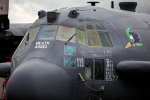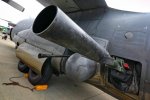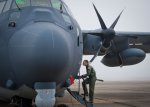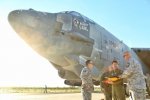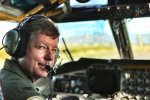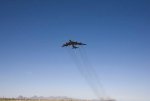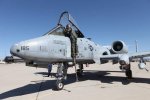pat038536
Member
- 185
- 0
- 16
- Location
- Sacramento CA
http://www.tinker.af.mil/news/story_print.asp?id=123436624
Gearing up for a 'Ghost' ride
by Kimberly Woodruff
Staff Writer
1/16/2015 - TINKER AIR FORCE BASE, Okla. -- With high demands on maturing aircraft, the Air Force is finding creative ways to save money on an aging fleet. With the chance of manufacturing a new B-52 out of the question -- because production ceased in the 1960s -- the Air Force is finding it more cost effective to regenerate it rather than repair it. Calling on the 309th Aerospace Maintenance and Regeneration Group, or 309th AMARG, an aircraft that has been in storage for more than six years will soon be back in the fleet. The original B-52 fleet had 744 aircraft; however, due to compliance with the Strategic Arms Reduction Treaty and Congressional mandates, the Air Force is left with just 76 in today's fleet. Last year, a mishap at Barksdale Air Force Base, La., left a B-52 severely damaged. Immediately following the incident, Tinker's B-52 System Program Office (SPO) teamed with Boeing to conduct engineering analysis, along with cost estimates. They proposed a course of action to Air Staff to retire the damaged jet and replace it with one from 309th AMARG, also known as the Air Force's "Boneyard," at Davis-Monthan AFB, Ariz.

While some personnel inspect the top of the left wing, others prepare to work in the No. 1 wheel well, as the aircraft sits in the Air Force’s “Boneyard” at Davis-Monthan Air Force Base, Ariz. (Air Force photo by Teresa Pittman, AMARG)
According to Capt. Chuck McLeod, a logistics career broadening officer and the B-52 SPO's team lead for the regeneration effort, "Salvaging a retired B-52 from the 'Boneyard' saves taxpayers money." He continued, "It's far too expensive to repair the damaged aircraft or manufacture a new bomber, not to mention there hasn't even been a new B-52 since 1962."
Choosing an aircraft
AMARG has maintained B-52H serial number 61-0007 in 1000-type storage, meaning it has the highest parts cannibalization restrictions requiring Headquarters Air Force approval for each part being requested. It is the most preserved level of aircraft storage with thin layers of strippable paint covering portions of the aircraft to protect it from the environment.
"Tail Number 61-0007, a former Minot Tail known as 'Ghost Rider,' was chosen after thorough inspections. It was a careful decision based on extensive engineering analysis. This aircraft has been exceptionally well preserved and maintained by the 309th AMARG team, which made the B-52 SPO's and Air Force Global Strike Command's recommendation to Air Staff to regenerate this tail number the obvious choice," Captain McLeod said.
Brenden Shaw, Air Force Life Cycle Management Center Logistics Branch chief, said, "61-0007 has fewer hours and is in excellent condition. In fact, according to one of the maintainers working at AMARG, this plane is in better shape than some of the ones currently in the fleet."
"This [re-commissioning of a B-52] has never been done in Air Force history," said retired Chief Master Sgt. Timothy Finch, a long time member of the B-52 community, who now works at Global Strike Command. "Everyone on the team is very excited."
Col. Keith Schultz, commander of the 307th Operations Group, 307th Bomb Wing at Barksdale AFB, will pilot the historic flight from the "Boneyard" to Barksdale. Colonel Schultz has flown the B-52 since 1980 and has a multitude of experiences in the Stratofortress. "I am the last of the Tall-Tail pilots (the old D model) who is still currently flying," he said, adding that, with more than 7,000 hours, he often volunteers for these challenging flights. "After delivering 18 B-52D and G models to the "Boneyard" over the years, it is about time I get to take one out."
Lt. Col. Darrel Hines, from Tinker's 10th Flight Test Squadron, will co-pilot and Capt. Carl Johnson, 2nd Operations Group, Barksdale, will serve as the navigator alongside Colonel Schultz.
Team effort
"This really is a cross-organizational team effort to get the plane operable," Captain McLeod said. "Air Force Global Strike Command, Defense Logistics Agency, 309th AMARG, 76th Aircraft Maintenance Group, AFGSC's 2nd and 5th Bomb Wings and AFRC's 307th Bomb Wing, are all working together to ensure the success of the mission."
Mr. Shaw credits Robin Benefield, a Logistics Management specialist at Tinker, with all of the initial coordination between Air Staff, Air Force Materiel Command, AFGSC, 309th AMARG and Tinker prior to the regeneration effort being approved to ensure the team was poised to begin work as soon as the word as given. "Ms. Benefield laid the groundwork for our success and will remain on the team until 61-0007 rejoins the fleet," Mr. Shaw said.
Senior Master Sgt. Gavin Smith, 307th Bomb Wing, AFRC, is leading regeneration efforts at the "Boneyard," in coordination with the B-52 System Program Office at Tinker and AFGSC.
SPO support includes engineering, technical orders, program management and a team of logistics professionals coordinating with their counterparts at Defense Logistics Agency to identify which parts are supportable and developing contingency plans for unsupportable items.
A diverse team is a tremendous value on a project this important. A shining example is when Karen Corley, a team member from the 76th AMXG, identified a Program Depot Maintenance (PDM) level task to remove and replace all fuel hoses, a safety of flight requirement only performed during PDM. While her input saved time and money for the regeneration effort, it more importantly prevented the potential of a catastrophic in-flight emergency. "Ms. Corley's involvement on the team is exceptionally critical to ensure we properly plan the work for 61-0007 arrival to the depot. Her efforts strengthen the team's relationship between AFLCMC and AFSC to ensure we deliver a reliable and viable weapon system back to the warfighter" said Mr. Shaw.
Melissa Alford, Logistics Management specialist in the B-52 SPO said, "prior to receiving Air Staff approval to go forward with the regen effort, the Logistics community took the initiative to look at all PDM Tasks that would need to be accomplished." She along with a team of logistics managers compiled a parts list for all PDM tasks and ran supportability assessments to determine if the Logistics Branch could support the requirements if the jet entered PDM today. Once those efforts were complete the lists were passed to engineering to verify all parts were accounted for so supportability could be determined, and forecast could be input. These efforts will ensure parts are available once the jet comes to PDM in 2015.
Flight worthy
"One of the biggest challenges is ensuring the aircraft is flight worthy for its flight to Barksdale," said Cody Boyd, lead engineer. "A lot has changed since 61-0007 last left PDM in 2004, so we had to be sure to catch everything to bring it up to configuration with the rest of the fleet." Mr. Shaw said, "Our team of engineers has looked at everything from a systems perspective and we're ahead of the game since we've integrated the entire community."
"The 309th AMARG is providing fantastic support to our team of maintainers working on 61-0007. While AMARG regenerates aircraft as a part of their day-to-day mission, their qualified personnel weren't current on a B-52H reactivation since there has never been a B-52 regenerated from AMARG," said Captain McLeod.
After the B-52 leaves the "Boneyard," it heads to Barksdale AFB where members from the 76th AMXG's Expeditionary Maintenance will salvage modifications from the damaged aircraft and install them on 61-0007 while Barksdale maintainers conduct routine inspections and repairs.
Tinker will accept the aircraft in late 2015 for a full PDM before it goes off into the blue to rejoin the active fleet in the summer of 2016. "We're working with AFGSC and 76th AMXG to determine which one-time through the fleet PDM tasks are supportable and required for 61-0007's first PDM since 2004," said Captain McLeod. He continued,
"Regardless of what those tasks are we will be prepared thanks to the tremendous planning and support of the entire regeneration team."
"She's an awesome aircraft with a very proud history of supporting Strategic Air Command's nuclear mission," Mr. Shaw said. "It's an absolute honor to be a small part of this historic achievement!"
-------------------------
There is another article located here: http://journalrecord.com/tinkertakeoff/2015/01/15/gearing-up-for-a-ghost-ride/
Gearing up for a 'Ghost' ride
by Kimberly Woodruff
Staff Writer
1/16/2015 - TINKER AIR FORCE BASE, Okla. -- With high demands on maturing aircraft, the Air Force is finding creative ways to save money on an aging fleet. With the chance of manufacturing a new B-52 out of the question -- because production ceased in the 1960s -- the Air Force is finding it more cost effective to regenerate it rather than repair it. Calling on the 309th Aerospace Maintenance and Regeneration Group, or 309th AMARG, an aircraft that has been in storage for more than six years will soon be back in the fleet. The original B-52 fleet had 744 aircraft; however, due to compliance with the Strategic Arms Reduction Treaty and Congressional mandates, the Air Force is left with just 76 in today's fleet. Last year, a mishap at Barksdale Air Force Base, La., left a B-52 severely damaged. Immediately following the incident, Tinker's B-52 System Program Office (SPO) teamed with Boeing to conduct engineering analysis, along with cost estimates. They proposed a course of action to Air Staff to retire the damaged jet and replace it with one from 309th AMARG, also known as the Air Force's "Boneyard," at Davis-Monthan AFB, Ariz.

While some personnel inspect the top of the left wing, others prepare to work in the No. 1 wheel well, as the aircraft sits in the Air Force’s “Boneyard” at Davis-Monthan Air Force Base, Ariz. (Air Force photo by Teresa Pittman, AMARG)
According to Capt. Chuck McLeod, a logistics career broadening officer and the B-52 SPO's team lead for the regeneration effort, "Salvaging a retired B-52 from the 'Boneyard' saves taxpayers money." He continued, "It's far too expensive to repair the damaged aircraft or manufacture a new bomber, not to mention there hasn't even been a new B-52 since 1962."
Choosing an aircraft
AMARG has maintained B-52H serial number 61-0007 in 1000-type storage, meaning it has the highest parts cannibalization restrictions requiring Headquarters Air Force approval for each part being requested. It is the most preserved level of aircraft storage with thin layers of strippable paint covering portions of the aircraft to protect it from the environment.
"Tail Number 61-0007, a former Minot Tail known as 'Ghost Rider,' was chosen after thorough inspections. It was a careful decision based on extensive engineering analysis. This aircraft has been exceptionally well preserved and maintained by the 309th AMARG team, which made the B-52 SPO's and Air Force Global Strike Command's recommendation to Air Staff to regenerate this tail number the obvious choice," Captain McLeod said.
Brenden Shaw, Air Force Life Cycle Management Center Logistics Branch chief, said, "61-0007 has fewer hours and is in excellent condition. In fact, according to one of the maintainers working at AMARG, this plane is in better shape than some of the ones currently in the fleet."
"This [re-commissioning of a B-52] has never been done in Air Force history," said retired Chief Master Sgt. Timothy Finch, a long time member of the B-52 community, who now works at Global Strike Command. "Everyone on the team is very excited."
Col. Keith Schultz, commander of the 307th Operations Group, 307th Bomb Wing at Barksdale AFB, will pilot the historic flight from the "Boneyard" to Barksdale. Colonel Schultz has flown the B-52 since 1980 and has a multitude of experiences in the Stratofortress. "I am the last of the Tall-Tail pilots (the old D model) who is still currently flying," he said, adding that, with more than 7,000 hours, he often volunteers for these challenging flights. "After delivering 18 B-52D and G models to the "Boneyard" over the years, it is about time I get to take one out."
Lt. Col. Darrel Hines, from Tinker's 10th Flight Test Squadron, will co-pilot and Capt. Carl Johnson, 2nd Operations Group, Barksdale, will serve as the navigator alongside Colonel Schultz.
Team effort
"This really is a cross-organizational team effort to get the plane operable," Captain McLeod said. "Air Force Global Strike Command, Defense Logistics Agency, 309th AMARG, 76th Aircraft Maintenance Group, AFGSC's 2nd and 5th Bomb Wings and AFRC's 307th Bomb Wing, are all working together to ensure the success of the mission."
Mr. Shaw credits Robin Benefield, a Logistics Management specialist at Tinker, with all of the initial coordination between Air Staff, Air Force Materiel Command, AFGSC, 309th AMARG and Tinker prior to the regeneration effort being approved to ensure the team was poised to begin work as soon as the word as given. "Ms. Benefield laid the groundwork for our success and will remain on the team until 61-0007 rejoins the fleet," Mr. Shaw said.
Senior Master Sgt. Gavin Smith, 307th Bomb Wing, AFRC, is leading regeneration efforts at the "Boneyard," in coordination with the B-52 System Program Office at Tinker and AFGSC.
SPO support includes engineering, technical orders, program management and a team of logistics professionals coordinating with their counterparts at Defense Logistics Agency to identify which parts are supportable and developing contingency plans for unsupportable items.
A diverse team is a tremendous value on a project this important. A shining example is when Karen Corley, a team member from the 76th AMXG, identified a Program Depot Maintenance (PDM) level task to remove and replace all fuel hoses, a safety of flight requirement only performed during PDM. While her input saved time and money for the regeneration effort, it more importantly prevented the potential of a catastrophic in-flight emergency. "Ms. Corley's involvement on the team is exceptionally critical to ensure we properly plan the work for 61-0007 arrival to the depot. Her efforts strengthen the team's relationship between AFLCMC and AFSC to ensure we deliver a reliable and viable weapon system back to the warfighter" said Mr. Shaw.
Melissa Alford, Logistics Management specialist in the B-52 SPO said, "prior to receiving Air Staff approval to go forward with the regen effort, the Logistics community took the initiative to look at all PDM Tasks that would need to be accomplished." She along with a team of logistics managers compiled a parts list for all PDM tasks and ran supportability assessments to determine if the Logistics Branch could support the requirements if the jet entered PDM today. Once those efforts were complete the lists were passed to engineering to verify all parts were accounted for so supportability could be determined, and forecast could be input. These efforts will ensure parts are available once the jet comes to PDM in 2015.
Flight worthy
"One of the biggest challenges is ensuring the aircraft is flight worthy for its flight to Barksdale," said Cody Boyd, lead engineer. "A lot has changed since 61-0007 last left PDM in 2004, so we had to be sure to catch everything to bring it up to configuration with the rest of the fleet." Mr. Shaw said, "Our team of engineers has looked at everything from a systems perspective and we're ahead of the game since we've integrated the entire community."
"The 309th AMARG is providing fantastic support to our team of maintainers working on 61-0007. While AMARG regenerates aircraft as a part of their day-to-day mission, their qualified personnel weren't current on a B-52H reactivation since there has never been a B-52 regenerated from AMARG," said Captain McLeod.
After the B-52 leaves the "Boneyard," it heads to Barksdale AFB where members from the 76th AMXG's Expeditionary Maintenance will salvage modifications from the damaged aircraft and install them on 61-0007 while Barksdale maintainers conduct routine inspections and repairs.
Tinker will accept the aircraft in late 2015 for a full PDM before it goes off into the blue to rejoin the active fleet in the summer of 2016. "We're working with AFGSC and 76th AMXG to determine which one-time through the fleet PDM tasks are supportable and required for 61-0007's first PDM since 2004," said Captain McLeod. He continued,
"Regardless of what those tasks are we will be prepared thanks to the tremendous planning and support of the entire regeneration team."
"She's an awesome aircraft with a very proud history of supporting Strategic Air Command's nuclear mission," Mr. Shaw said. "It's an absolute honor to be a small part of this historic achievement!"
-------------------------
There is another article located here: http://journalrecord.com/tinkertakeoff/2015/01/15/gearing-up-for-a-ghost-ride/
Last edited:




